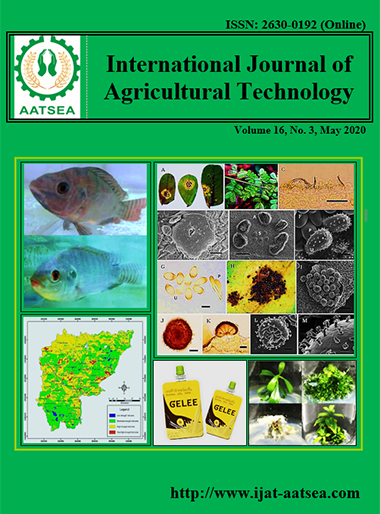Callus and hairy root induction of Melaleuca cajuputi Powell
Main Article Content
Abstract
It is stated that the lowest percentage of contamination at 49.63% and highest percentage of survival at 37.95% after sterilized with 70% ethanol for 1 min and 1.8 % NaOCl for 30 min. The bud explants were cultured on Murashige and Skoog (MS) medium supplemented with 0, 0.02, 0.04, 0.06, 0.08 mg/l 2,4-Dinitrophenylhylhydrazine (2,4-D) combination with 0, 0.02, 0.04, 0.06, and 0.08 mg/l Thidiazuron (TDZ) for callus induction. The results showed that the explants were cultured on MS medium supplemented with 0.06 mg/l TDZ resulting to be suitable for callus induction with biggest size at 2.56x1.26 cm of width and length. Culturing buds on MS medium supplemented with 0.02 mg/l TDZ had the highest averaged shoot number. The roots were cultured in liquid MS medium supplemented with 0.04 mg/l TDZ, 0.04 mg/l 2.4-D gave the highest weight of hairy roots.
Article Details

This work is licensed under a Creative Commons Attribution-NonCommercial-NoDerivatives 4.0 International License.
References
Craven, L. A. and Barlow, B. A. (1999). New Taxa and new combination in Melaleuc (Myrtaceae). Novon, 7:113-119.
Das, J., Mao, A. A. and Handique, P. J. (2012). Callus-mediated organogenesis and effect of growth regulators on production of different valepotriates in Indian valerian (Valeriana jatamansi Jones.). Acta Physiologiae Plantarum, 35:55- 63.
Dhiman, N., Patial, V. and Bhattacharya, A. (2018). The current status and future application of hairy root culture. In: Kumer, N. (2018). Biotechnological approaches for medicinal and aromatic plants. Springer, pp. 87-155.
Huetteman, C. A. and Preece, J. E. (1993). Thidiazuron: A potent cytokinin for woody plant tissue culture. Plant Cell Tissue and Organ Culture, 33:105-119.
Hutchinson, J. F., Beardsel, D. V. l. and Comb, J. A. M. (1985). Propagation by tissue culture introduction. In horticulture of Australian plants. Western Australian. Dept. Agriculture, South Perth, W. A., pp. 38-52.
Nuyim, T. and Benjachaya, S. (2007). Melaeuca cajuputi wood processing guide. Retrieved from http://forprod.forest.go.th/forprod/samadkhow/Samadkhow.pdf.
Oyen, L. P. A. and Dung, N. X. (1999). Plant resources of South-East Asia. No.19. Essential Oil Plants. Backhuys Publishers, Leiden, The Netherlands.
Taji, A. M. and Williams, R. R. (1996). Tissue culture of Australian plants. Australia: University of New England Press. Armidale. NSW, pp. 1-15.
Thinh, P. T. (1997). Zones and their functions in Tram chim National Reserve. In Towards Sustainable Management of Tram Chin National Reserve, Vietnam. Proceedings of a Workshop on Balancing Economic Development with Environmental Conservation. (ed Safford, R.J., D.V. Ni, E. Maltby and V.-T. Xuan) London: Royal Holloway Institute for Enivironmental Research, pp. 77-85.
Southwell, I. and Lowe, R. (1999). Tea tree, The genus Melaleuca. Medicinal and aromatic plants: Industrial profile: Volume 9, Harwood academic Publishers, pp. 11-28.
Zhang, Z. Yu, Z. Jin, Z. Liu, J. and Li, Y. (2013). Liquid culture of adventitious roots is a potential alternative to field cultivation for Psammosilene tunicoides, a rare and endangered endemic medicinal plant. Advance Journal of Food Science and Technology, 5:127-131.


